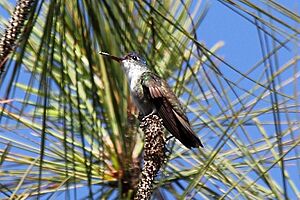Azure-crowned hummingbird facts for kids
Quick facts for kids Azure-crowned hummingbird |
|
|---|---|
 |
|
| Conservation status | |
| Scientific classification | |
| Genus: |
Saucerottia
|
| Species: |
cyanocephala
|
| Synonyms | |
|
Ornismya cyanocephalus Lesson 1829, Amazilia cyanocephala |
|
The azure-crowned hummingbird (Saucerottia cyanocephala) is a beautiful bird known for its bright blue head. It's a type of hummingbird that belongs to a group called "emeralds." You can find this hummingbird in several countries in Central America, including Belize, El Salvador, Guatemala, Honduras, Mexico, and Nicaragua.
Contents
About Its Name
This hummingbird was first given the name Ornismya cyanocephalus. Later, it was moved to a different group, or genus, called Amazilia.
Scientists who study birds often use molecular phylogenetics, which looks at DNA, to understand how birds are related. A study in 2014 showed that the Amazilia group was not made up of birds that were all closely related. Because of this, many scientists decided to move the azure-crowned hummingbird to a different, older genus called Saucerottia.
There are two slightly different types, or subspecies, of the azure-crowned hummingbird:
- S. c. cyanocephala
- S. c. chlorostephana
What It Looks Like
The azure-crowned hummingbird is a small bird, about 10 to 11.5 centimeters (4 to 4.5 inches) long. Males usually weigh about 5.8 grams, and females are a bit lighter at 5.4 grams. That's about the weight of two pennies!
Both male and female hummingbirds have a black upper part of their bill and a dull pink lower part with a black tip.
Colors of the Main Subspecies
In the main subspecies, S. c. cyanocephala, adult males have a bright, shiny metallic blue crown (the top of their head). Females have a duller blue or greenish-blue crown.
Both sexes have a metallic bronze color on their neck and back. Their lower back, upper tail feathers, and tail are greenish-bronze. Their face is mostly bluish-green.
Their chest and belly are white, but the sides of their chest are metallic bronze-green. Their sides are a duller bronze-green.
Colors of the Other Subspecies
The S. c. chlorostephana subspecies is a little smaller. Its colors are mostly the same as the main subspecies, but its crown is a sparkling green instead of metallic blue.
Young hummingbirds look similar to adults but are not as brightly colored. They might have grayish-buff tips on their upper tail feathers and whitish tips on their outer tail feathers. Their underparts might also have a buff (light yellowish-brown) tint.
Where It Lives
The main subspecies, S. c. cyanocephala, lives from the Mexican state of Tamaulipas all the way south through Belize, Guatemala, and El Salvador, into north-central Nicaragua.
It likes to live on the edges of humid evergreen forests, oak and pine-oak forests, and scrublands. It also lives in secondary forest, which is forest that has grown back after being cut down. You can find these birds at elevations between 600 and 2400 meters (about 2,000 to 7,900 feet) above sea level.
The other subspecies, S. c. chlorostephana, lives in a separate area. It is found on the Mosquito Coast in eastern Honduras and northeastern Nicaragua. This subspecies mostly lives in pine savannas, which are grasslands with scattered pine trees, at lower elevations.
How It Behaves
Movement
The azure-crowned hummingbird usually stays in one place and does not migrate long distances. However, it might move short distances depending on the season, perhaps looking for food or better conditions.
Feeding
This hummingbird mostly eats nectar from flowers. It looks for nectar from the lower parts of the forest all the way up to the treetops.
Sometimes, it flies a regular route to visit flowers, which is called trap-lining. Other times, it defends a specific area of flowers from other birds to make sure it has enough food.
In pine savannas, people have seen it hovering near clusters of pine needles and in bark crevices. It's not fully known if it was hunting small insects or visiting tiny flowers that grow on other plants, called epiphytes.
Breeding
The breeding season for the azure-crowned hummingbird changes depending on where it lives. Generally, it seems to breed from February to July.
It builds a cup-shaped nest using materials that are available nearby. The nest is usually placed in a fork of a branch or "saddled" over a branch. In cities, some nests have even been found on utility wires!
Vocalization
One sound the azure-crowned hummingbird makes is a low, buzzy dzzzrt. It makes this sound both when flying and when sitting still. When perched, it might repeat this sound steadily.
It also makes a "fairly mellow, strong chipping" sound. Sometimes, these chips can turn into a fast trill or rattle. The calls of the isolated S. c. chlorostephana subspecies might be different, but scientists haven't described them separately yet.
Its Conservation Status
The IUCN (International Union for Conservation of Nature) has evaluated the azure-crowned hummingbird. They have listed it as a species of "Least Concern." This means that it is not currently considered to be at risk of extinction.
This hummingbird has a large area where it lives, and its population is estimated to be at least 500,000 adult birds. Even though the population is thought to be decreasing, no immediate major threats have been found. Human activities probably don't have a big short-term effect on the azure-crowned hummingbird.



